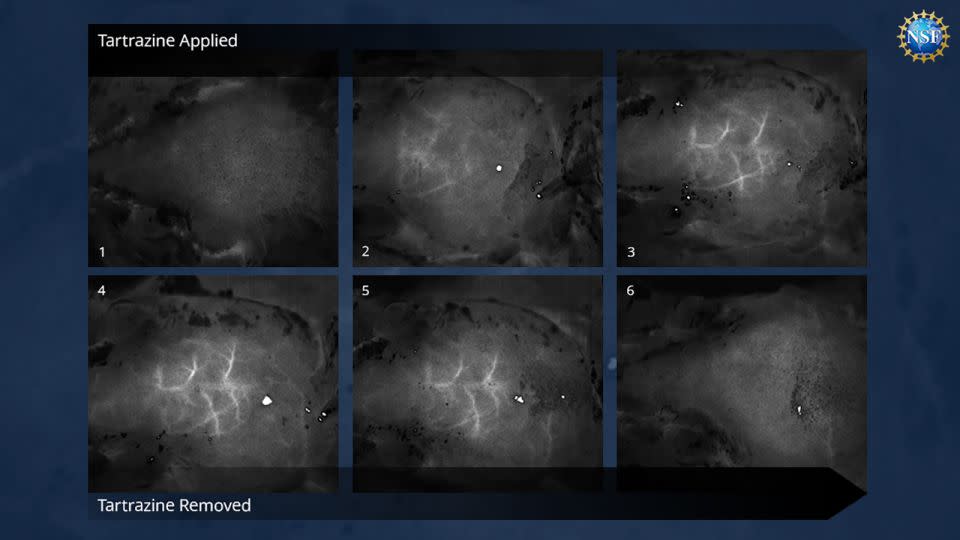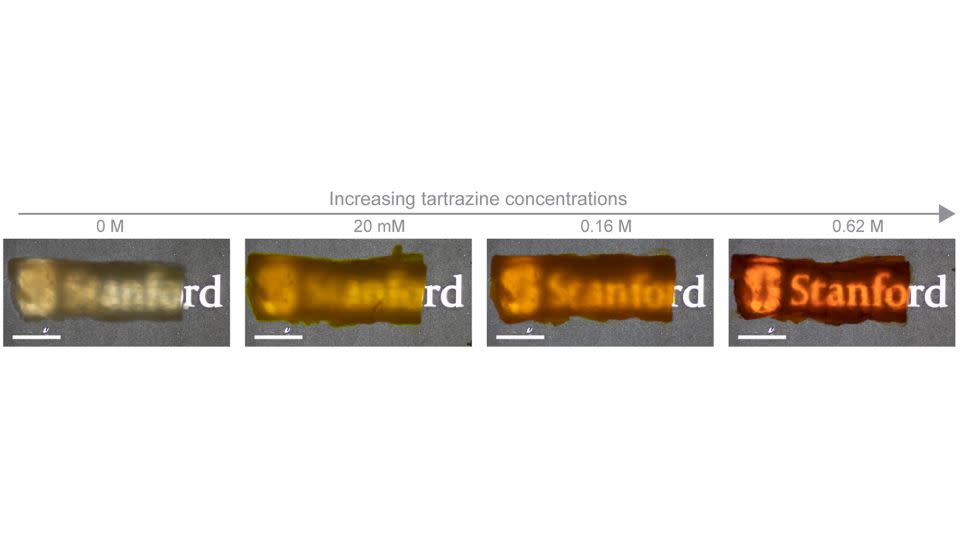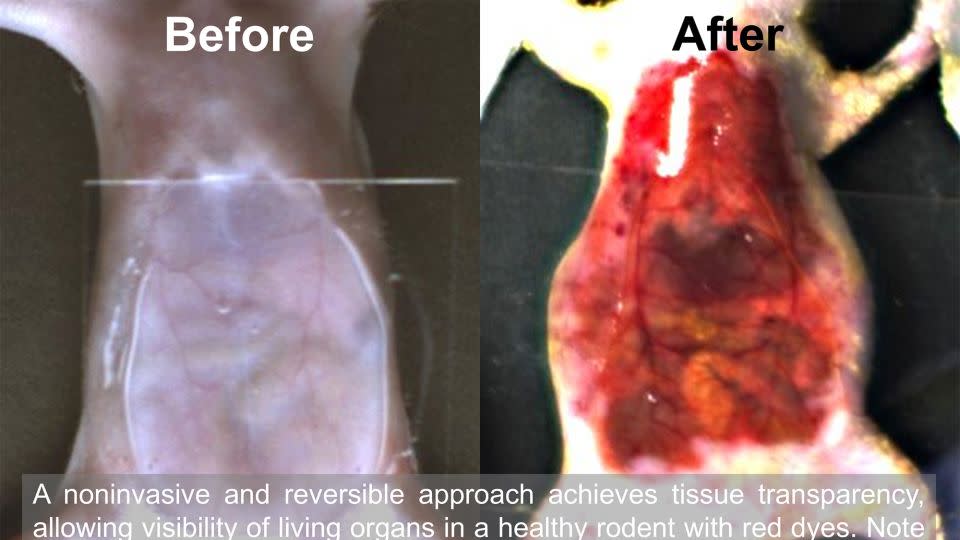Sign up for CNN’s Wonder Theory science newsletter. Explore the universe with news about fascinating discoveries, scientific advances and more.
In H.G. Wells’ 1897 science fiction novel “The Invisible Man,” the hero invents a serum that controls how the cells in his body bend light, making them transparent.
More than 100 years later, scientists have discovered a real-life version of the substance: A common food dye can temporarily turn a mouse’s skin transparent, allowing scientists to see its organs functioning, according to a new study published Thursday in the journal Science.
The invention could revolutionise biomedical research and, if successfully tested in humans, could have wide-ranging applications in medicine and healthcare, such as making veins more visible for blood draws.
The researchers made the skin on the skulls and bellies of live mice transparent by applying a mixture of a yellow food dye called tartrazine and water. Washing off the remaining solution reversed the process, which did not harm the animals. The mice’s fur was removed before applying the solution.
“It makes sense to those who understand the basic physics behind it, but if you’re unfamiliar with it, it looks like a magic trick,” Zihao Ou, the study’s first author and an assistant professor of physics at the University of Texas at Dallas, said in a statement.

Light-absorbing dye molecules
The “magic” uses insights from the field of optics. Light-absorbing dye molecules suppress the tissue’s ability to scatter light, increasing the transmission of light through the skin.
When mixed with water, the dye changes the refractive index (a measure of how well a substance bends light) of the watery part of the tissue to better match the index of the proteins and fats in the tissue. The process is similar to a cloud of fog dispersing.
“We combined the yellow dye, a molecule that specifically absorbs most of the blue and ultraviolet light, with a scattering medium, the skin,” said Ou, who conducted the work as a postdoctoral researcher at Stanford University in California.
“These two things individually block most of the light from passing through them,” he said. “But when we put them together, we were able to achieve the transparency of mouse skin.”
When the dye penetrates the skin completely, the skin becomes transparent.
“It takes a few minutes for the transparency to appear,” Ou said. “It’s similar to how a facial cream or mask works: The time required depends on how quickly the molecules diffuse into the skin.”
The team conducted experiments on chicken breasts before conducting studies on live animals.
In mice, the researchers were able to directly observe blood vessels on the surface of the brain through the transparent skin of the skull, as well as see the muscles contracting to move internal organs in the abdomen and food through the digestive tract.


The transparent areas took on an orange hue, similar to food coloring, Ou said.
The dye used in the solution is known as FD&C Yellow No. 5, which is approved for use by the U.S. Food and Drug Administration. The synthetic dye is often used in orange or yellow snack chips, candy coatings, ice cream, and baked goods. However, a 2021 study by the California Office of Environmental Health Hazard Assessment linked the coloring to behavioral difficulties and decreased attention in children. A state bill, if passed into law, would ban the use of food coloring in foods served in California public schools.
Ou said it was important that the dye was biocompatible, meaning it was safe for living organisms. “It’s also very cheap and effective; we don’t need a lot of it to make it work,” he said.
Possible biomedical applications for humans
The researchers haven’t tested the process in humans, and it’s not clear what dye dosage or application method would be needed. Human skin is about 10 times thicker than a mouse’s, according to the researchers.
“Looking to the future, this technology could make veins more visible, making blood draws or fluids administered via needle easier, especially for older patients whose veins are difficult to find,” said Guosong Hong, senior author and assistant professor of materials science at Stanford University, via email.
“Additionally, this innovation could aid in the early detection of skin cancer, improve light penetration in deep tissue treatments such as photodynamic and photothermal therapies, and make laser-based tattoo removal easier.”


Christopher Rowlands, a senior lecturer in bioengineering at Imperial College London, said he was “frustrated” that the Stanford-led team had failed to come up with the same insight, based on a widely studied and long-standing physics principle called Kramers-Kronig relations: When a material absorbs too much light of one color, it will bend light of other colors more.
“It’s obvious when someone points it out, but no one had thought about it for 100-odd years,” said Rowlands, who was not involved in the study but co-authored a commentary published with the research.
Rowlands, along with Jon Gorecki, an experimental optical physicist at the same institution who was not involved in the study, wrote that this approach offers a new way to safely, temporarily and noninvasively visualize the structure and activity of deep tissues and organs in a living animal.
“It just works. You put it on a mouse and you can see what it had for breakfast. It’s that powerful,” he added.
Current methods for making tissue transparent use solutions that have side effects such as dehydration and swelling, and can alter the structure of the tissue, Rowlands and Gorecki said. However, tartrazine was used at a low concentration and its effects were easily eliminated, potentially facilitating long-term studies of biological processes in living animals, they wrote.


The duo said the discovery was an example of life imitating art, with the dye solution mirroring the serum imagined in the movie “The Invisible Man.”
“The hero invents a serum that makes the cells in his body transparent by precisely controlling their refractive index to match the surrounding medium, air,” they wrote.
“One hundred and twenty-seven years later… biocompatible dyes make living tissue transparent by adjusting the refractive index of the surrounding medium to match the refractive index of cells.”
But Ou and Hong say the idea of a completely invisible mouse is far-fetched: With the current approach, it’s not possible to make the bone transparent.
“So far, we have only tested soft tissues such as brain, muscle and skin. We haven’t done much research on hard tissues such as bone, so I’m not sure we can make the mouse completely invisible,” Ou said via email.
“However, a partially transparent (mouse) will provide a wealth of research opportunities to answer questions about development, regeneration and aging.”
For more CNN news and bulletins, create an account at CNN.com